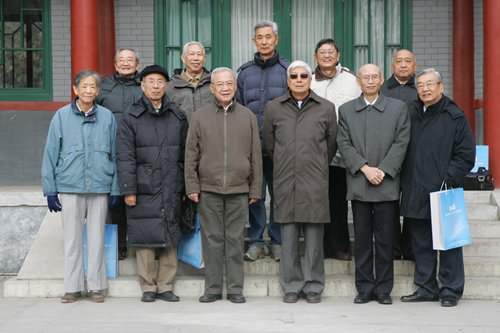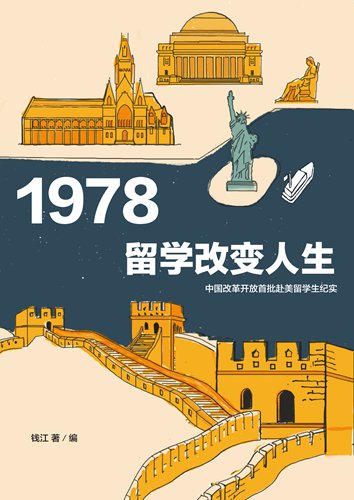Source: Global Times (7/11/17)
First group of Chinese mainland students to study in US after Cultural Revolution talk about their experiences in recent book
By Li Jingjing

Eleven members of the first group of 52 students sent to the US in 1978 pose for a picture in 2009. Photo: Courtesy of Qian Jiang
While it may be a common sight to run into a student from the Chinese mainland at universities around the world today – more than half a million students from China went abroad for educational purposes in 2016 – a little more than 40 years ago you would be hard-pressed to find a single one. That all changed in 1978, when top Chinese leader Deng Xiaoping made the decision after the end of Cultural Revolution (1967-77) to send out a large number of students to study abroad. Deng felt that this move would be a vital part of China’s reform and opening-up.
Rebuilding
During the Cultural Revolution, many universities in China shut down. To help repair the damage the country’s education system suffered during this time period Deng reinstated the national college entrance examinations, or gaokao, in 1977 and postgraduate exams in 1978, and arranged for students to be sent abroad so they could bring knowledge of advanced technology back to China.
Improved China-US relations opened the door for 52 Chinese scholars to study in the US.
On December 26, 1978, less than a week before China and the US established diplomatic relations, these scholars boarded a plane and left their homeland behind. After transferring in Pakistan and later France, they finally arrived in the US, where they would study for the next two years.
How Deng came to this decision, how the students were chosen and how their time overseas impacted their lives is all recorded in a new book from veteran journalist Qian Jiang – Stories of the First Post-reform Chinese Students to Study in the US.

Stories of the First Post-reform Chinese Students to Study in the US Photo: Courtesy of Qian Jiang
An experienced journalist and former deputy editor-in-chief of the People’s Daily Overseas Edition, Qian began researching or interviewing these 52 scholars in 2009.
In the first part of his book, Qian provides extensive data and information that lays out the background for the decision to send these students overseas. In the second half, he includes interviews with 42 of the 52 scholars as well as three officials who worked to send the students .
“Our interviews and research record their footprints and reflect on their successes and failures. Our goal was to preserve their memories to provide comprehensive materials for future studies on overseas study and education,” Qian told the Global Times.
Culture shock
Besides the natural curiosity that comes with being a journalist, Qian became interested in the history of these scholars due to his own personal experiences.
The 63-year-old Qian was one of the many students who took the reinstated gaokao in 1977. Years later, he also had the opportunity to study in the US when he became a visiting scholar at John Hopkins University in 1991. These experiences helped him understand what these scholars had to go through to be chosen for the program.
After the 10-year education gap that occurred during the Cultural Revolution, passing the gaokao was an extremely difficult challenge for many Chinese at the time. Naturally, qualifying to study overseas was even more difficult, especially considering the lack of English study materials in the mainland at the time.
The 52 scholars were chosen from among 14,714 students who signed up to take the overseas student exams.
Qian said that out of the 52 scholars, whose average age was 40, only two had advanced English skills, while the rest of the students’ English level was roughly equal to a Chinese middle school student today.
“But these people were extraordinarily intelligent,” Qian said, pointing out that these scholars were the elites of their chosen fields of science, engineering and medicine.
This was the first time that the People’s Republic of China had sent students abroad. It was also the first time that any of these scholars had traveled outside their home country.
The differences in culture and lifestyle came as a great shock.
Qian explained that while on the flight to the US, some scholars didn’t dare ask for a glass of orange juice because they were afraid that flight attendants would charge them for it.
The endless stream of cars on the streets of Washington DC and supermarkets in which customers could choose what they wanted without limit was something they had never seen before back at home.
The greatest shock, however, came from the advancements in science.
“Every one of us studied as hard as we could because we saw how far behind we had fallen during the Cultural Revolution,” Li Zhuxia, a research fellow at the China Institute of Atomic Energy and one of the 52 scholars, remarked in one of the interviews from the book.
“We felt that the only way to repay our country was to study very hard, learn new knowledge and then bring that knowledge back to China,” she said.
After two years of hard work, most of them returned and became professors or research fellows, serving as pillars in their respective fields. Meanwhile, their pioneering efforts overseas helped pave the way for future Chinese students going abroad.
For example, mathematician Zhang Gongqing helped establish a research team focusing on nonlinear analysis at Peking University. Today, many of his students are outstanding mathematicians in their own right.
“I think studying abroad changed the academic outlook of our generation. It enabled us to leave an academic environment that had fallen far behind and go learn new skills in what was at the time the academic center of the world,” Zhang explains in the book.